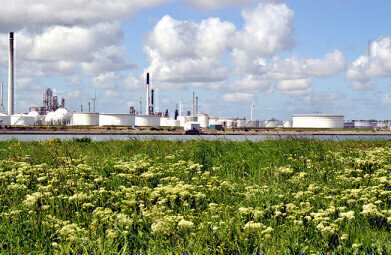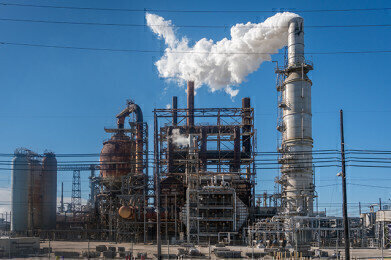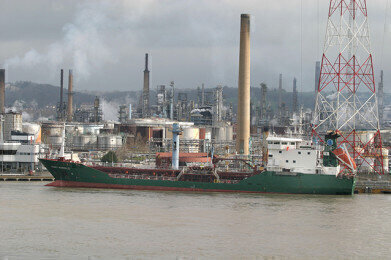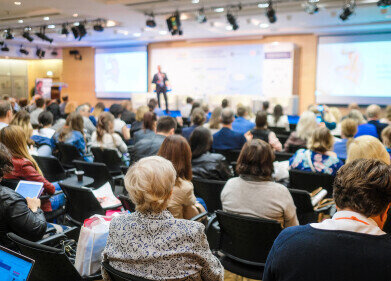-
 Rozenburg refinery, Rotterdam
Rozenburg refinery, Rotterdam -
 Refinery at Port Arthur, Texas
Refinery at Port Arthur, Texas -
 Port Jerome refinery, France
Port Jerome refinery, France
Fuel for Thought
VSA, membrane and PSA technologies for carbon capture from hydrogen production on refinery SMRs
Jul 01 2021
Author credit – Stephen B. Harrison and Maria James, sbh4 consulting
Desulphurisation of refined products has become standard practice as liquid fuel specifications have become more stringent. Hydrotreating is a widely accepted technique in refineries to remove sulphur from various oil fractions and create marketable products such as Ultra Low Sulphur Diesel (ULSD).
Currently, the predominant production route of hydrogen for use in refineries is steam methane reforming (SMR). SMR uses natural gas or refinery gas as its feedstock and about 80% of current global hydrogen production is derived from fossil fuels, with SMR technology. Methane and steam are converted into syngas with a typical composition of 76% hydrogen, 17% CO2, and 7% unreacted methane and other gases. An SMR typically emits 9.5 kg of CO2 per kg of hydrogen, making hydrogen produced by SMRs from fossil fuels without carbon capture unsustainable.
Currently, CO2 is either emitted into the atmosphere or, in the production of ammonia for urea fertilizers, it is captured using an amine-wash process. Typically, in such cases, the flue gases are contacted against water to cool them and remove particulates. This is followed by a twin-tower of amine-based CO2 absorption and CO2 stripping. About 90% of the CO2 is removed from the flue gases which are emitted from the absorber. The stripper produces a high purity CO2 stream.
An amine wash system can be used for carbon capture on refinery SMRs. Alternative options are to use membranes and PSA or VSA adsorption systems to capture the CO2 emissions. Two process flow sheet options using this mix of technologies have been piloted at refineries in the USA and Europe to capture the CO2 content from the process gases leaving the SMR. In the first scenario, the hydrogen PSA does not separate any additional impurities after the SMR. In a second process flow sheet, the CO2 is sequestered from the hydrogen PSA tail gas. The very high CO2 concentration in the hydrogen PSA tail gas of more than 80% may make this process flow sheet favourable.
VSA CO2 capture from refinery SMR at Port Arthur, USA
To capture CO2 from the tail gas of the SMR hydrogen purification PSA unit, a vacuum swing adsorption VSA process has been implemented by Air Products at a refinery in Port Arthur, Texas. To capture the CO2 content of the product gas, the VSA unit has been inserted between the SMR and the hydrogen PSA unit. CO2 can be produced with a purity of 95% and a recovery rate of over 90%.
To function, the VSA adsorber vessels are sequentially fed with CO2-rich product gas at pressure and then depressurised to a vacuum to release the CO2 from the adsorbent material. CO2 is selectively adsorbed on the adsorbent bed and the hydrogen-rich gas that flows through the carbon capture VSA system is fed into the hydrogen PSA system for further purification.
To release the CO2, the pressure in the VSA adsorber vessel is reduced to below atmospheric pressure. Then the bed is returned to a higher-pressure bed to purge and clean the vessel. About 90% of the carbon dioxide is removed using this VSA equipment, which results in a million tonnes of CO2 being captured annually: a major contribution to decarbonising refinery hydrogen production.
At Port Arthur, the CO2 is then compressed by an intercooled 8-stage centrifugal compressor to about 70 bar, which is above the triple point of CO2. A 21 km CO2 pipeline leg connects the VSA units to an existing CO2 transmission pipeline that runs 500 km to oil fields in Texas and Louisiana where the captured CO2 is used for Enhanced Oil Recovery (EOR).
Membrane and PSA CO2 capture from refinery SMRs in Europe
Air Liquide has developed a CO2 sequestration method that captures CO2 from the CO2-rich tail gas from SMR hydrogen PSA units. In the first stage of the process, an additional PSA system removes water vapour from the PSA tail gas. Non-condensable gases go to a cryogenic membrane system, where additional hydrogen and CO2 are recovered.
The process increases hydrogen productivity by 10-20%, as well as achieving a CO2 recovery rate of more than 98%. Residual gases are sent back to the reformer burner, where their energy is used to drive the reforming reaction.
A demonstration plant using this process has been installed at the Port-Jérôme refinery in Normandy, France. It can capture 100,000 tonnes of CO2 per year. A planned second installation of the technology for an existing SMR at the Rozenburg refinery in Rotterdam will have a CO2 capture capacity of 500,000 tonnes of CO2 per year. Subject to FID and other project milestones, the Rozenburg refinery SMR carbon capture facility could be operational in 2024, making another huge contribution to the decarbonisation of refinery hydrogen production on SMR units.
Digital Edition
PIN 25.1 Feb/March
March 2024
In This Edition Safety - The technology behind the ION Science Tiger XT - Safety with ammonia and LOHCs as hydrogen carriers Analytical Instrumentation - Discussion on new tribology te...
View all digital editions
Events
Apr 28 2024 Montreal, Quebec, Canada
Apr 30 2024 Birmingham, UK
May 03 2024 Seoul, South Korea
May 05 2024 Seville, Spain
May 06 2024 Riyadh, Saudi Arabia

















